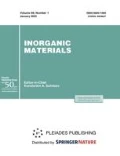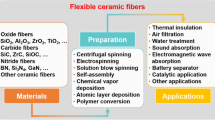Abstract
We have studied the effect of iron oxides (0–10 wt % in terms of FeO) on the fabrication conditions and properties of continuous Fe-containing glass fibers and have determined the temperature ranges of fiber fabrication. A relationship between the iron oxide content of glass and the fiber fabrication temperature has been established. Using differential scanning calorimetry and x-ray diffraction, we have investigated the effect of glass composition on the glass transition temperature and temperature range of crystallization of the fibers. At high iron oxide contents (5–10 wt %), the first to crystallize is magnetite, otherwise quartz appears first. Increasing the heat-treatment temperature leads to crystallization of pigeonite, augite, enstatite, anorthite, and labradorite.
Similar content being viewed by others
References
Dzhigiris, D.D. and Makhova, M.F., Osnovy proizvodstva bazal’tovykh izdelii (Fundamentals of Basalt Technology), Moscow: Teploenergetika, 2002.
Zak, A.F., Fiziko-khimicheskie svoistva steklyannogo volokna (Physicochemical Properties of Glass Fibers), Moscow: Rostekhizdat, 1962.
Aslanova, M.S., Kolesov, Yu.I., Khazanov, V.E, et al., Steklyannye volokna (Glass Fibers), Moscow: Khimiya, 1979.
Dubrovskii, V.A., Makhova, M.F., and Perveeva, L.A., A Thermoanalytical Technique for Determining the Lower Temperature Limit of Glass Crystallization, in Metody issledovaniya tekhnologicheskikh svoistv (Methods of Engineering Performance Assessment), Moscow: VNIIESM, 1970, pp. 40–43.
Trefilov, V.I., Sergeev, V.P., and Makhova, M.F., RF Patent 2102342.
Lazoryak, B.I., Filaretov, A.A., and Moiseev, E.A., Protsess polucheniya i izuchenie fiziko-mekhanicheskikh svoistv nepreryvnykh volokon (Fabrication and Mechanical Properties of Continuous Fibers), Moscow: Mosk. Gos. Univ., 2006.
Ariskin, A.A. and Barmina, G.S., Modelirovanie fazovykh ravnovesii pri kristallizatsii bazal’tovykh magm (Modeling of Phase Equilibria in Crystallization of Basalt Magmas), Moscow: Nauka, 2000.
Author information
Authors and Affiliations
Corresponding author
Additional information
Original Russian Text © E.A. Moiseev, S.I. Gutnikov, A.P. Malakho, B.I. Lazoryak, 2008, published in Neorganicheskie Materialy, 2008, Vol. 44, No. 9, pp. 1148–1152.
Rights and permissions
About this article
Cite this article
Moiseev, E.A., Gutnikov, S.I., Malakho, A.P. et al. Effect of iron oxides on the fabrication and properties of continuous glass fibers. Inorg Mater 44, 1026–1030 (2008). https://doi.org/10.1134/S0020168508090215
Received:
Accepted:
Published:
Issue Date:
DOI: https://doi.org/10.1134/S0020168508090215




